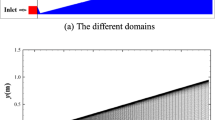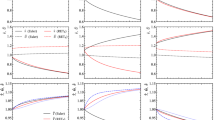Abstract
As recognized previously, a minimum-length nozzle has the smallest possible throat-to-exit length that is still capable of maintaining uniform supersonic flow at the nozzle exit. In the present study, for the flow of moist air through a nearly minimum-length nozzle designed by the method of characteristics, the effects of nonequilibrium condensation on the uniformity of flow properties, the momentum efflux, and the flow distortion at the nozzle exit plane are discussed by experiment and numerical analysis of a third-order Total Variation Diminishing (TVD) finite difference scheme. The onset and zone of nonequilibrium condensation in a minimum-length nozzle are quite different from those of a general convergent-divergent supersonic nozzle. We know that the uniformity of flow properties at the nozzle exit with regard to the flow with nonequilibrium condensation in a minimum-length nozzle cannot be guaranteed. On the other hand, owing to the positions of the onset of condensation at the incident region of expansion waves from the sharp corner just downstream of the nozzle throat, the deceleration gradient and magnitude of heat released from the process of nonequilibrium condensation to the surrounding of ϕ0=60% are greater than those of ϕ0=70% in the case of T0=290K. Furthermore, it has been determined that the decrease in efflux of momentum from the nozzle exit for the stagnation relative humidity of ϕ0=70%(T0=290K), which corresponds to the case with nonequilibrium condensation shock, is 6.8% smaller than that of isentropic expansion.
Similar content being viewed by others
References
P. P. Wegener, Nonequilibrium flow with condensation, Acta Mechanica, 21(1–2) (1975) 65.
R. A. Oriani and B. E. Lundquist, Emendations to Nucleation Theory and the Homogeneous Nucleation of Water from the Vapour, J.Chem.Phys., 38 (1963) 2082.
J. Lothe and G. M. Pound, In Nucleation, edited by Zettlemoyer, A. C. Marcel Dekker, New York, (1969) chpt. 3.
J. P. Sislian and I. I. Glass, Condensation of Water Vapour in Rarefaction Waves: I. Homogeneous Nucleation, Dec., AIAA, J., 14(12) (1976) 1731–1737.
S. C. Baek, S. B. Kwon, H. D. Kim, T. Setoguchi and S. Matsuo, Study of Moderately Underexpanded Supersonic Moist Air Jets, AIAA, J., 44(7) (2006) 1624–1627.
S. B. Kwon and H. J. Ahn, Supersonic Moist Air Flow with Condensation in a Wavy Wall Channel, KSME, Int.J, 15(4) (2001) 492–499.
S. C. Baek, S. B. Kwon and H. D. Kim, Passive Prandtl-Meyer Expansion Flow with Homogeneous Condensation, KSME,Int.J., 18(3) (2004) 407–418.
M. Stastny and M. Sejna, Numerical Simulation of the Steam Flow with Condensation in a Nozzle, 14th Int. Conf. on the Properties of Water Steam in Kyoto, (2004) 637–642.
J. D. Anderson Jr., Gas dynamic Lasers: An Introduction, Academic, New York (1976).
B. K. Hodge and K. Koenig, Compressible Fluid Dynamics with Personal Computer Applications, Prentice Hall, Upper Saddle River, NJ. (1995) 466–477.
H. Y. Wachman, The Thermal Accommodation Coefficient: A Critical Survey, ARS J, 32(9) (1962) 2–12.
U. Dohrmann, Ein Numerisches Verfahren zur Berechnung stationarer transsonischer Stromungen mit Energiezufuhr durch homogene Kondensation, doctors der Ingenieurwissenschaften, Uni. Karlsruhe (1989).
S. Adam and G. Schnerr, Instabilities and Bifurcation of Nonequilibrium Two-phase Flows, Journal of Fluid Mechanics, 348 (1997) 1–28.
B. S. Baldwin and H. Lomax, Thin Layer Approximation and Algebraic Model for Separated Turbulent Flows, AIAA, 257 (1978) 9.
H. C. Yee, A Class of High Resolution Explicit and Implicit Shock-capturing Methods, NASA, TM-89464 (1989).
Author information
Authors and Affiliations
Corresponding author
Additional information
This paper was recommended for publication in revised form by Associate Editor Do Hyung Lee
Soon-Bum Kwon received his B.S. and M.S. degrees in Mechanical Engineering from Kyungpook National University in 1974 and 1980, respectively, and his Ph.D. degree from Kyushu University in 1987. He is a Professor at the School of Mechanical Engineering at Kyungpook National University. His research interests are compressible gas dynamics and nonequilibrium condensation.
Rights and permissions
About this article
Cite this article
Kwon, SB., Lee, SJ., Shin, SY. et al. A study on the flow with nonequilibrium condensation in a minimum length nozzle. J Mech Sci Technol 23, 1736–1742 (2009). https://doi.org/10.1007/s12206-009-0421-5
Received:
Revised:
Accepted:
Published:
Issue Date:
DOI: https://doi.org/10.1007/s12206-009-0421-5




